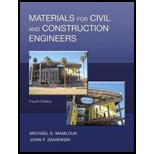
Materials for Civil and Construction Engineers (4th Edition)
4th Edition
ISBN: 9780134320533
Author: Michael S. Mamlouk, John P. Zaniewski
Publisher: PEARSON
expand_more
expand_more
format_list_bulleted
Concept explainers
Question
Chapter 8, Problem 8.1QP
To determine
Write the definition of solid and hollow masonry units according to ASTM C90.
Expert Solution & Answer
Explanation of Solution
Solid masonry:
It is termed as a masonry unit whose net cross-sectional area
Hollow masonry:
The net cross-sectional area
Want to see more full solutions like this?
Subscribe now to access step-by-step solutions to millions of textbook problems written by subject matter experts!
Students have asked these similar questions
Please explain step by step and show formulas
5. (20 Points) Consider a channel width change in
the same 7-foot wide rectangular in Problem 4.
The horizontal channel narrows as depicted
below. The flow rate is 90 cfs, and the energy
loss (headloss) through the transition is 0.05
feet. The water depth at the entrance to the
transition is initially 4'.
1
b₁
TOTAL ENERGY LINE
V² 129
У1
I b₂
TOP VIEW
2
PROFILE VIEW
h₁ = 0.05
EGL
Y₂ = ?
a)
b)
c)
2
Determine the width, b₂ that will cause a
choke at location 2.
Determine the water depth at the
downstream end of the channel transition (y₂)
section if b₂ = 5 feet. Calculate the change in
water level after the transition.
Plot the specific energy diagram showing
all key points. Provide printout in homework.
d) What will occur if b₂ =
= 1.5 ft.?
4. (20 Points) A transition section has been
proposed to raise the bed level a height Dz in a
7-foot wide rectangular channel. The design
flow rate in the channel is 90 cfs, and the
energy loss (headloss) through the transition is
0.05 feet. The water depth at the entrance to
the transition section is initially 4 feet.
b₁ = b = b2
1
TOTAL ENERGY LINE
V² 129
Ут
TOP VIEW
2
hloss = 0.05
"
EGL
Y₂ = ?
PROFILE VIEW
a) Determine the minimum bed level rise, Dz,
which will choke the flow.
b) If the step height, Dz = 1 ft, determine the
water depth (y2) at the downstream end of the
channel transition section. Calculate the
amount the water level drops or rises over the
step.
c) Plot the specific energy diagram showing all
key points. Provide printout in Bework.
d) What will occur if Dz = 3.0 ft.?.
Crest
Front View
Chapter 8 Solutions
Materials for Civil and Construction Engineers (4th Edition)
Ch. 8 - Prob. 8.1QPCh. 8 - Prob. 8.2QPCh. 8 - Prob. 8.3QPCh. 8 - Prob. 8.4QPCh. 8 - Prob. 8.5QPCh. 8 - Prob. 8.6QPCh. 8 - Prob. 8.7QPCh. 8 - Prob. 8.8QPCh. 8 - Prob. 8.9QPCh. 8 - Prob. 8.10QP
Ch. 8 - Prob. 8.11QPCh. 8 - A portion of a medium-weight concrete masonry unit...Ch. 8 - A portion of a concrete masonry unit was tested...Ch. 8 - A concrete masonry unit was tested according to...Ch. 8 - Prob. 8.15QPCh. 8 - Prob. 8.16QPCh. 8 - A severe weathering clay brick was tested for...Ch. 8 - Prob. 8.18QPCh. 8 - What is the grout? What is the grout used for?Ch. 8 - Prob. 8.20QP
Knowledge Booster
Learn more about
Need a deep-dive on the concept behind this application? Look no further. Learn more about this topic, civil-engineering and related others by exploring similar questions and additional content below.Similar questions
- 1. (20 Points) Determine the critical depth in the trapezoidal drainage ditch shown below. The slope of the ditch is 0.0016, the side slopes are 1V:2.5H, the bottom width is b = 14', and the design discharge is 500 cfs. At this discharge the depth is y = 4.25'. Also, determine the flow regime and calculate the Froude number. Ye= ? Z barrow_forward3. (20 Points) A broad crested weir, 10 feet high, will be constructed in a rectangular channel B feet wide. The weir crest extends a length of B = 120 feet between the banks with 2 - 4 foot wide, round nosed piers in the channel. The width of the weir crest is 8 feet. If H = 6', determine the design discharge for the weir.arrow_forwardParking Needs vs. Alternative Transportation Methods for presentation slides include images and graphsarrow_forward
- Please explain step by step and show formulararrow_forwardBeam ABD is supported and loaded as shown. The cross-section of the beam is also shown. The modulus of elasticity of the beam is 200 GPa. 6.0 kN/m Cross-section: 330 mm 4.5 kN 8.0 kNm 40 mm 2.5 m 1.5 m 20 mm Set up the discontinuity moment function in terms of x. List all the appropriate boundary conditions. Determine the slope function in terms of x. Determine the deflection function in terms of x. Determine the support reactions. Determine the maximum deflection. 290 mmarrow_forwardDraw the Shear Force Diagram and Bending Moment Diagram for the beam shown in Fig.1. The beam is subjected to an UDL of w=65m. L=4.5m L1= 1.8m. Assume the support at C is pinned, and A and B are roller supports. E = 200GPa, I = 250x106 mm4.arrow_forward
- Calculate the BMs (bending moments) at all the joints of the beam shown in Fig.1 using the Slope Deflection method. The beam is subjected to an UDL of w=65m. L=4.5m L1= 1.8m. Assume the support at C is pinned, and A and B are roller supports. E = 200GPa, I = 250x106 mm4.arrow_forwardText Book Problem 7.82 (page 261) Consider the total head-loss in the system forthis flow is 18.56 ft (head-losses in first and second pipe are 13.83 ft and 4.73 ftrespectively). Please show numerical values for EGL/HGL at the beginning/end/intermediatechange point. (Point distribution: elevation determination 5 points, EGL, HGL lines 4points).(I think we are just using the values provided for head losses to solve this problem)arrow_forwardCalculate the BMs (bending moments) at all the joints of the beam shown in Fig.1 using the moment distribution method, and draw the Shear force diagram and Bending moment diagram for the beam shown. The beam is subjected to an UDL of w=65m. L=4.5m L1= 1.8m. Assume the support at C is pinned, and A and B are roller supports. E = 200GPa, I = 250x106 mm4.arrow_forward
- Calculate the BMs (bending moments) at all the joints of the beam shown in Fig.1 using the Slope deflection method. The beam is subjected to an UDL of w=65m. L=4.5m L1= 1.8m. Assume the support at C is pinned, and A and B are roller supports. E = 200GPa, I = 250x106 mm4.arrow_forwardThank you for your help if you would also provide the equations used .arrow_forwardThe sectors are divided as follows:top right = 1, top left = 2, middle = 3, bottom = 4.(a) Determine the distance yˉ to the centroid of the beam’s cross-sectional area.Solve the next questions by building a table. (Table format Answers) (b) Determine the second moment of area (moment of inertia) about the x′ axis. (c) Determine the second moment of area (moment of inertia) about the y-axis.arrow_forward
arrow_back_ios
SEE MORE QUESTIONS
arrow_forward_ios
Recommended textbooks for you
 Construction Materials, Methods and Techniques (M...Civil EngineeringISBN:9781305086272Author:William P. Spence, Eva KultermannPublisher:Cengage Learning
Construction Materials, Methods and Techniques (M...Civil EngineeringISBN:9781305086272Author:William P. Spence, Eva KultermannPublisher:Cengage Learning Fundamentals Of Construction EstimatingCivil EngineeringISBN:9781337399395Author:Pratt, David J.Publisher:Cengage,
Fundamentals Of Construction EstimatingCivil EngineeringISBN:9781337399395Author:Pratt, David J.Publisher:Cengage, Architectural Drafting and Design (MindTap Course...Civil EngineeringISBN:9781285165738Author:Alan Jefferis, David A. Madsen, David P. MadsenPublisher:Cengage Learning
Architectural Drafting and Design (MindTap Course...Civil EngineeringISBN:9781285165738Author:Alan Jefferis, David A. Madsen, David P. MadsenPublisher:Cengage Learning Traffic and Highway EngineeringCivil EngineeringISBN:9781305156241Author:Garber, Nicholas J.Publisher:Cengage Learning
Traffic and Highway EngineeringCivil EngineeringISBN:9781305156241Author:Garber, Nicholas J.Publisher:Cengage Learning

Construction Materials, Methods and Techniques (M...
Civil Engineering
ISBN:9781305086272
Author:William P. Spence, Eva Kultermann
Publisher:Cengage Learning

Fundamentals Of Construction Estimating
Civil Engineering
ISBN:9781337399395
Author:Pratt, David J.
Publisher:Cengage,

Architectural Drafting and Design (MindTap Course...
Civil Engineering
ISBN:9781285165738
Author:Alan Jefferis, David A. Madsen, David P. Madsen
Publisher:Cengage Learning

Traffic and Highway Engineering
Civil Engineering
ISBN:9781305156241
Author:Garber, Nicholas J.
Publisher:Cengage Learning